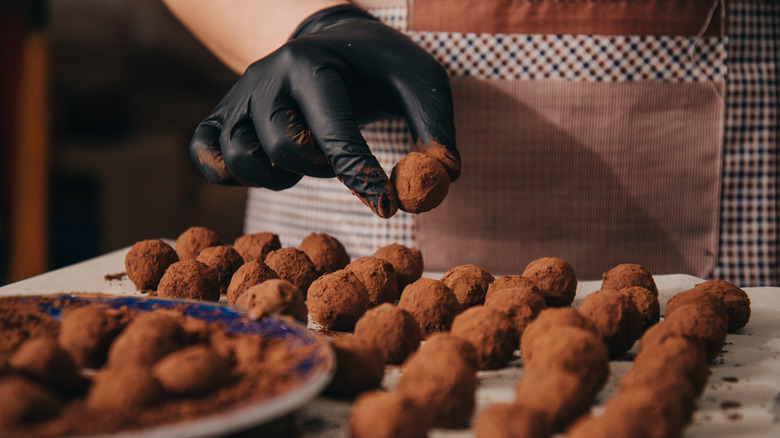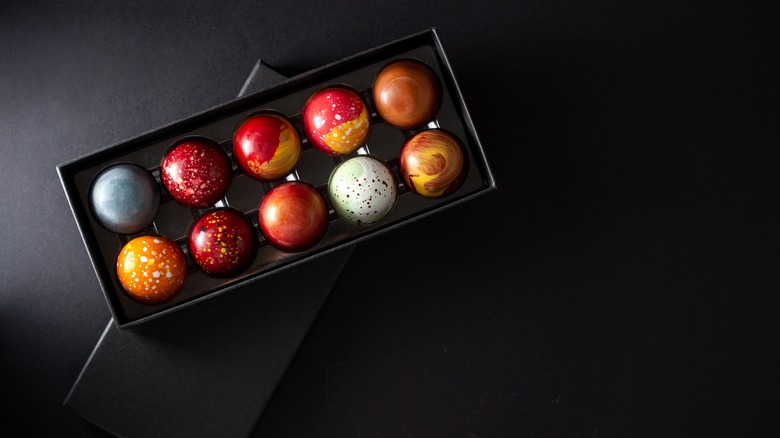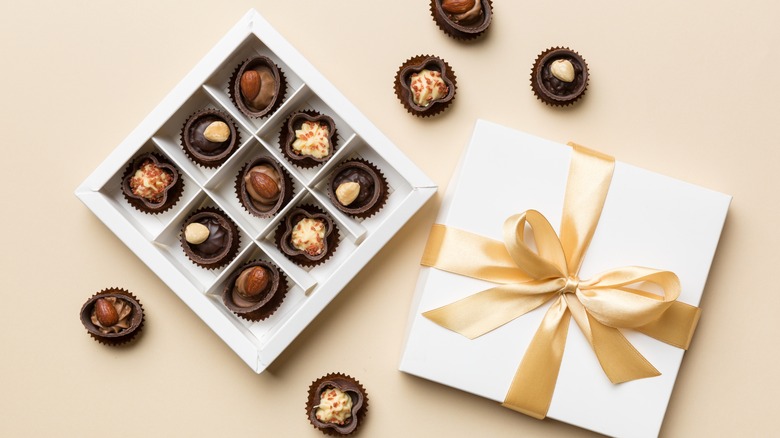The Texture Red Flags To Avoid In A Box Of Fancy Chocolates
Why wait for the next holiday? Bonbons and truffles are sweet all year long. And it's easy to pick the best of the bunch. A few sensory clues are the best indicator of when a truffle is truly terrific and when a bonbon is more of a boo-boo. And sure, Valentine's Day spurs chocolate sales with a reported $23.9 billion in consumer spending last year alone. Still, we can think of at least a dozen reasons to indulge more regularly.
Truffles and bonbons have a tasty reputation. Though their names are sometimes used interchangeably, the difference is in the filling. Truffles are little bites of rich and decadent dark chocolate ganache – chocolate and cream. Vegans, take note — we don't necessarily mean dairy cream. Coconut cream is one potential substitution, and even chocolate can be vegan.
The ganache is tempered and hand-rolled into a sphere, then coated in a harder chocolate shell. The truffle is often coated in nuts, candied fruit, a dusting of powder like cocoa, or a range of creative edible options.
Bonbons, on the other hand, most often use non-chocolate fillings. The center of a bonbon might be nougat, a cream, a fruit, curd, or any number of delectable, tempting options. Flavors in chocolate alone fill their own sensory and flavor wheels or possible profiles from earthy to fruity or spicy, and beyond. Pair that with the possibilities of fillings, and the result is a product that might leap into your mouth.
A truffle is more than a trifle
For many of us, it's true that we eat with our eyes first, and that's a great place to start the search for a great chocolate morsel. When choosing a boxed chocolate candy, pick one with a shiny exterior and a smooth surface free from blotches. This chocolate has been well-tempered. Avoid any dull, dusty, crumbly chocolates. A classically "good" chocolatier's chocolate has a sheen — it's glossy and silky. When you touch the chocolate, your fingerprints shouldn't leave a mark. That's another sign of well-tempered and stored chocolate.
Conversely, chocolate with splotches or white dustiness has bloomed, having fat crystals settling on its surface. The chocolate is still safe to eat, but it's not worth the high dollar amounts you might spend on a well-handled piece of nosh.
When holding the chocolate, it shouldn't immediately melt, rather, it should melt slowly. Touching it should also release a scent of chocolate, not of spiciness or other aromas. But let's be real, you're popping that thing in your mouth. In the case of a truffle, you'll snap into a thin outer chocolate shell to get to the ganache in the center. That shell should be audible and hopefully, satisfying, providing a texture contrast to the center filling that it protected.
Chocolate Factory tasting notes
Aside from a good snap on your tongue, great chocolate does a bit more in your mouth. It should not feel greasy, waxy, or chalky. The chocolate should have a well-balanced flavor without grittiness or grains. Ideally, sweetness will not be the dominant note, since good chocolate has an entire range of flavors to pick up on.
Ultimately, good chocolate is a subjective experience. If you love a bit of crumbly, waxy, bitter chocolate, there's no reason not to indulge in exactly that. If chalky chocolate reminds you of your sweet old grandpa, enjoy it. Curiosity about traditionally "great" food may lead you down a road paved with a different type of dessert, and should you decide to treat yourself, knowledge is power. Arm yourself with a few consensus quick and dirty tips and you'll know how to choose the best of the best in a shop full of fancy delicacies. A lot of what you're looking for in fancy chocolate is the same thing you look for in regular chocolate — color, consistency, feel, and taste. The fun snapping shell is just an added bonus.


